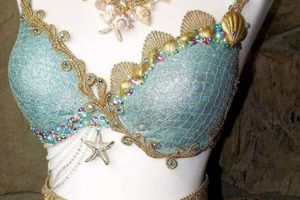Creating a costume inspired by the “Operation” board game, often involving do-it-yourself methods, represents a specific type of creative endeavor. This undertaking generally entails replicating the game’s iconic imagery a prone figure with various ailments through clothing and accessories. An example would be constructing a flat, human-shaped form out of cardboard or fabric and attaching representations of the game’s “funatomy” pieces (e.g., a wishbone, a water-on-the-knee bucket) to the figure. These can be created from felt, foam, or other readily available craft materials.
The practice of crafting such a costume offers several benefits. It encourages resourcefulness and ingenuity by repurposing existing materials and promoting problem-solving in the construction process. Further, it provides a unique and recognizable visual identity, suitable for themed parties, Halloween events, or theatrical productions. Historically, homemade costumes have served as a cost-effective and personalized alternative to commercially produced options, allowing for greater individual expression and creativity.
The subsequent sections will delve into specific techniques for constructing various components of this type of costume, offering guidance on material selection, assembly methods, and potential design variations for achieving a visually compelling and functionally sound result.
Construction Advisory
The following guidelines offer practical advice for the successful development of “Operation” game-inspired attire, focusing on achieving accurate representation and structural integrity.
Tip 1: Material Selection: Prioritize lightweight yet durable materials for the base form. Corrugated plastic or foam board provide a stable structure without excessive weight, crucial for maneuverability.
Tip 2: Anatomical Accuracy: Reference official “Operation” game imagery for precise placement and relative size of the ailment components. Discrepancies can diminish the costume’s recognizability.
Tip 3: Attachment Security: Employ robust adhesives and fasteners for attaching the ailment pieces to the base form. Velcro or snap closures allow for easy removal and reattachment, mimicking the game’s interactive element.
Tip 4: Visual Clarity: Use contrasting colors for the base form and ailment pieces to enhance visibility, particularly in low-light environments. Bright, saturated hues increase visual impact.
Tip 5: Mobility Considerations: Design the costume to allow for a full range of motion. Excessive size or rigid construction can impede movement and create safety hazards. Consider strategic cutouts or flexible joints.
Tip 6: Illumination Enhancement: Incorporate battery-operated LED lights to highlight specific ailment pieces, adding a dynamic visual element and improving visibility. Ensure proper insulation and secure wiring.
Tip 7: Wearer Comfort: Integrate padding or cushioning to minimize chafing and pressure points, particularly in areas of direct contact with the wearer’s body. Prioritize wearer well-being.
Adhering to these recommendations will enhance the visual appeal, structural integrity, and overall wearability of the “Operation” game-themed attire, resulting in a successful and memorable creation.
The succeeding section will address potential variations and creative enhancements for further customization of the costume.
1. Base Material Durability
In the context of crafting an “Operation” game-themed costume, the durability of the base material is a critical factor influencing the costume’s longevity, structural integrity, and overall suitability for its intended use. The base material forms the primary structure of the costume, typically mimicking the shape of the game’s patient character. A weak or fragile material is prone to damage during construction, transport, or wear, potentially leading to structural failure and compromising the costume’s visual appeal. For instance, using thin cardboard as the base material might result in bending, tearing, or collapse under its own weight or from minor impacts.
The choice of a more durable material, such as corrugated plastic or thick foam board, provides increased resistance to these stresses. These materials offer a balance between weight and structural strength, allowing for a costume that can withstand repeated use and handling. The implications of selecting a durable base extend beyond mere aesthetics. A more robust base allows for more secure attachment of the “funatomy” pieces, preventing them from detaching during wear. This is particularly important if the costume is intended for interactive use, where others may be manipulating or touching the various components. In contrast, a flimsy base may cause attachments to tear away, rendering the interactive elements unusable.
In summation, prioritizing base material durability in the creation of an “Operation” game costume is essential for ensuring its longevity, structural integrity, and functionality. While cost considerations may influence material choices, the long-term benefits of selecting a more durable option outweigh the initial expense, leading to a costume that can be enjoyed for multiple occasions. Understanding the connection between base material durability and the overall success of the costume is a fundamental principle in costume design and fabrication.
2. Anatomical Accuracy
In the context of constructing a costume replicating the “Operation” board game, anatomical accuracy serves as a cornerstone for visual recognition and effective communication of the costume’s intended theme. Fidelity to the game’s stylized, albeit simplified, human form directly impacts the immediate understanding and appreciation of the costume by observers.
- Placement of Ailments
The precise positioning of the various ailments, or “funatomy” pieces, on the costume’s base form is paramount. Deviation from the established locations depicted in the “Operation” game can lead to confusion and diminished recognizability. For instance, incorrectly placing the “wishbone” on the leg instead of the chest disrupts the visual cue that viewers rely on to identify the costume’s source material. Accuracy in placement, therefore, reinforces the intended reference and elevates the overall impact.
- Relative Size and Scale
Maintaining proportional consistency between the base human form and the ailment components is crucial for achieving visual harmony and realism, within the stylized confines of the game’s design. A disproportionately large “water-on-the-knee” bucket, for example, can appear comical or detract from the overall presentation. Accurate scaling of the elements contributes to a more believable and visually appealing representation of the game’s subject matter.
- Shape and Form F
idelityReplicating the distinct shapes and forms of the individual ailment pieces adds to the costume’s authenticity. Each piece possesses a characteristic silhouette that contributes to its recognizability. The “butterfly in the stomach,” the “Charlie horse,” and the “wrench” all have unique shapes that must be accurately represented. Deviation from these established forms weakens the costume’s connection to the original game and can confuse viewers.
- Color Palette Replication
While not directly anatomical, adherence to the game’s color scheme for the ailments reinforces the costume’s visual identity. The consistent use of specific colors for particular pieces (e.g., a red nose, a white wishbone) further enhances the costume’s recognizability and allows for immediate association with the “Operation” game. Inaccurate color choices can dilute the visual impact and weaken the costume’s overall effect.
In conclusion, meticulous attention to anatomical accuracy, encompassing ailment placement, scaling, form, and color, is vital for crafting a compelling and recognizable “Operation” game-themed costume. These elements work in concert to create a cohesive and effective representation of the source material, allowing the costume to effectively communicate its intended message and engage with its audience.
3. Attachment Security
Attachment security represents a crucial, yet frequently underestimated, element in the successful execution of a costume directly inspired by the “Operation” board game. This stems from the inherent design of the costume, which necessitates the secure affixation of multiple, often three-dimensional, components representing the game’s various ailments to a base structure mimicking the patient’s body. Inadequate attachment security directly correlates with a diminished visual impact and a potentially compromised user experience. For example, if the “wishbone” component is loosely attached using weak adhesive, it may detach during wear, especially under conditions of movement or contact. This detachment detracts from the costume’s recognizability and can necessitate on-the-spot repairs, disrupting the wearer’s intended experience. The principle of cause and effect is clearly demonstrated: insufficient attachment leads to component failure and diminished costume effectiveness.
The selection of appropriate attachment methods and materials is paramount. Simple glue may prove insufficient for securing heavier or more frequently manipulated pieces. Alternatives, such as high-strength adhesives, mechanical fasteners (e.g., screws or rivets embedded in durable backing), or hook-and-loop closures, offer significantly enhanced security. Hook-and-loop closures, specifically, introduce an element of interactivity mirroring the game itself, allowing components to be temporarily removed and reattached. However, the bond strength of the adhesive backing on these closures must be sufficient to withstand repeated use. Real-world examples underscore the importance of robust attachment. Consider a scenario where a child is wearing the costume at a Halloween event; without secure attachment, the costume’s various ailment pieces are likely to become detached and potentially lost in the crowd. The practical significance of understanding and implementing robust attachment methods therefore directly impacts the costume’s usability and overall effectiveness.
In conclusion, attachment security constitutes an indispensable consideration in the crafting of an “Operation” game-themed costume. Its importance stems from the costume’s reliance on multiple individual components that must remain securely affixed to the base structure. The challenges lie in selecting appropriate attachment methods and materials that balance security, ease of use, and visual aesthetics. Prioritizing attachment security ensures the costume remains visually compelling, functional, and durable throughout its intended use, ultimately enhancing the wearer’s experience and the costume’s overall impact.
4. Visibility Enhancement
In the context of an “Operation” game-themed costume crafted through do-it-yourself methods, visibility enhancement plays a multi-faceted role exceeding mere aesthetic considerations. It directly affects both safety and the clarity with which the costume conveys its intended theme. A costume lacking adequate visibility, particularly in environments with low ambient lighting, presents a safety hazard to the wearer. Dimly lit parties, crowded streets, or nighttime events increase the risk of accidental collisions or falls if the wearer is not easily seen. Furthermore, even in well-lit conditions, poor visibility can obscure the costume’s intricate details, diminishing its recognizability and impact.
Visibility enhancement in this type of costume can be achieved through various methods. Incorporating reflective materials, such as tape or fabric, into the costume’s design significantly increases its visibility in low-light conditions by reflecting light from external sources, such as headlights or flashlights. Strategic placement of light-emitting diodes (LEDs) provides direct illumination, further enhancing visibility and creating a visually striking effect. The selection of bright, contrasting colors for both the base of the costume and the ailment components ensures that the costume stands out against its surroundings. For instance, a costume employing a dark base with brightly colored ailments will be more easily discernible than one utilizing muted or monochromatic tones. Consider a real-world example of a child wearing an “Operation” costume at a nighttime Halloween parade. Without adequate visibility enhancement, the child could be easily overlooked by drivers or other pedestrians, creating a potentially dangerous situation. Conversely, a costume incorporating reflective elements and LED lighting significantly increases the child’s visibility, ensuring their safety and allowing the costume to be fully appreciated by onlookers.
Ultimately, visibility enhancement is an integral component of a well-executed “Operation” game costume. Its practical significance lies in its ability to enhance safety, improve recognizability, and maximize the costume’s visual impact. While creativity and accuracy in replicating the game’s aesthetic are important, neglecting visibility can compromise the costume’s effectiveness and potentially endanger the wearer. Therefore, incorporating visibility-enhancing elements into the design and construction of an “Operation” game costume should be a primary consideration, alongside other factors such as material selection and anatomical accuracy. This ensures a costume that is not only visually appealing but also safe and easily identifiable, achieving its intended purpose effectively.
5. Wearer Mobility
Wearer mobility constitutes a primary functional concern in the design and construction of an “Operation” game-themed costume. This is due to the inherent potential for such costumes to be bulky or restrictive, given their often rigid structure and the presence of protruding “ailment” components. A significant reduction in wearer mobility directly impacts the costume’s practicality, safety, and overall enjoyment. The cause
-and-effect relationship is clear: a poorly designed costume restricting movement leads to increased fatigue, difficulty navigating crowded spaces, and a heightened risk of accidents. For example, a costume with a wide, inflexible base may impede the wearer’s ability to pass through doorways or climb stairs, rendering it unsuitable for many social settings.
Importance of Wearer Mobility as a Component of Operation Game Costume DIY:
Safety: Unrestricted movement is crucial for avoiding trips, falls, and collisions, particularly in low-light conditions or crowded environments.
Practicality: The wearer should be able to perform basic actions such as sitting, reaching, and using restrooms without significant difficulty.
Comfort: Limited mobility leads to discomfort and fatigue, reducing the duration the costume can be worn and diminishing the wearer’s overall experience.
Aesthetic Impact: A wearer struggling to move gracefully within a costume detracts from its visual appeal, regardless of its accuracy or creativity. A real-life example includes a person attending a costume party; if limited by the costume’s design, the wearer’s inability to dance or comfortably interact with others diminishes the costume’s effectiveness.
Therefore, prioritizing wearer mobility necessitates careful consideration of several design factors, including:
Material Selection: Employing lightweight and flexible materials for the base structure minimizes weight and allows for a greater range of motion.
Costume Size and Shape: Avoiding excessive bulk and streamlining the costume’s silhouette reduces the likelihood of collisions and improves maneuverability.
Joint Articulation: Incorporating flexible joints or hinges at key points, such as the hips and shoulders, allows for greater freedom of movement.
Strategic Cutouts: Creating cutouts in the base structure in areas that would otherwise restrict movement (e.g., around the arms and legs) improves range of motion.
The practical significance of understanding these considerations lies in creating a costume that is not only visually striking but also functional and comfortable to wear, enhancing the overall experience for the wearer and maximizing the costume’s intended impact. Failing to adequately address wearer mobility can render an otherwise impressive “Operation” game-themed costume impractical and ultimately unsuccessful.
6. Cost-Effectiveness
The concept of cost-effectiveness holds considerable relevance when approaching an “Operation” game costume through do-it-yourself methodologies. This stems from the potential for commercially available costumes, particularly those of specialized or niche themes, to incur significant financial expenditure. Undertaking a do-it-yourself approach, therefore, presents an opportunity to mitigate these costs through the strategic utilization of readily available and often less expensive materials. The cause-and-effect relationship is directly apparent: selecting budget-friendly resources, such as repurposed cardboard, fabric remnants, and inexpensive craft supplies, directly reduces the overall investment required to create the costume. The absence of cost-consciousness can lead to expenses rivaling or even exceeding those of commercially produced alternatives, thereby negating the primary benefit of a do-it-yourself project. In this context, the importance of cost-effectiveness as a component of creating an “Operation” game costume revolves around maximizing the value derived from the expended resources.
Consider a scenario where an individual seeks to acquire a professionally crafted “Operation” game costume for a themed event. The purchase price for such a costume could easily range from $100 to $300, depending on the level of detail and material quality. Alternatively, by adopting a do-it-yourself approach and employing materials sourced from household discards and discount retailers, the same costume could be replicated for a fraction of the cost, potentially under $50. However, achieving this cost-effectiveness necessitates careful planning and resource management. This includes meticulously assessing available materials, prioritizing the utilization of repurposed items, and strategically sourcing new supplies from outlets offering competitive pricing. Furthermore, skill in crafting and construction plays a crucial role. Time investment must be factored into the equation as labor is substituted for monetary expenditure. Failure to plan adequately or underestimating the time commitment can result in a partially completed costume or the need to purchase additional materials, thereby eroding the anticipated cost savings.
In summary, the pursuit of cost-effectiveness is a fundamental driver for many individuals undertaking an “Operation” game costume as a do-it-yourself project. The potential for significant savings compared to commercial alternatives necessitates careful planning, resource management, and efficient execution. While skill, time investment, and material choices all contribute to achieving the desired outcome, a conscious focus on minimizing expenditure without compromising the costume’s visual impact or structural integrity remains paramount. The challenge lies in striking a balance between cost reduction and quality, ensuring the final product effectively captures the essence of the “Operation” game theme while remaining within a predetermined budget. The practical significance of understanding these factors is clear: it empowers individuals to create unique and engaging costumes without incurring excessive financial burden, thereby democratizing access to creative expression and self-presentation.
7. Construction Simplicity
Construction simplicity, in the context of creating a costume inspired by the “Operation” board game through do-it-yourself methods, refers to the degree of complexity involved in the fabrication process. Its significance stems from its direct impact on accessibility, time investment, and the likelihood of successful completion for individuals with varying skill levels. A design requiring advanced technical expertise or specialized tools poses a barrier to entry, limiting participation and potentially resulting in an unfinished or poorly executed costume. Therefore, prioritizing construction simplicity is essential for maximizing the reach and appeal of “operation game costume diy”.
- Pattern Design & Complexity
The intricacy of the pattern design dictates the level of cutting, sewing, and assembly required. A design employing numerous small pieces, complex curves, or advanced sewing techniques demands greater precision and skill. In contrast, a simplified pattern utilizing larger, geometrically simple shapes streamlines the construction process. For example, a rectangular base form with easily attachable, pre-cut ailment pieces requires less technical expertise than a form with intricate curves and tailored seams. Complex patterns invariably increase the time required for construction and the potential for errors, thus reducing overall simplicity.
- Material Selection & Manipulation
The choice of materials influences the ease of manipulation and assembly. Materials requiring specialized tools or techniques, such as rigid plastics or complex fabrics, increase the difficulty level. C
onversely, utilizing readily available and easily workable materials like felt, foam board, or cardboard simplifies the construction process. For instance, felt can be easily cut, glued, and sewn without requiring specialized equipment. A costume primarily constructed from such materials is inherently more accessible and requires less technical proficiency. Complicated materials introduce new difficulties which ultimately diminish construction simplicity. - Attachment Methods & Techniques
The methods used to attach the various components, particularly the ailment pieces, significantly impact construction simplicity. Techniques involving complex sewing, intricate wiring, or specialized fasteners increase the difficulty level. Simplifying attachment by utilizing readily available adhesives, hook-and-loop closures, or basic stitching techniques streamlines the process. For instance, attaching felt ailment pieces to a foam board base using craft glue is significantly simpler than using complex wiring to illuminate each piece. Reducing these difficulties streamlines project completion.
- Tool Requirements & Accessibility
The tools required to construct the costume directly affect its accessibility and simplicity. Designs necessitating specialized equipment, such as 3D printers, laser cutters, or advanced sewing machines, limit participation to those with access to such tools. Prioritizing designs that can be executed using readily available household tools, such as scissors, craft knives, and basic sewing needles, increases accessibility. A costume that can be fully constructed with minimal tool requirements is inherently simpler to create, widening the potential audience and ensuring greater participation in “operation game costume diy”.
In conclusion, construction simplicity represents a pivotal consideration in the realm of “operation game costume diy,” influencing its accessibility, time investment, and ultimate success. By prioritizing simplified pattern designs, easily workable materials, straightforward attachment methods, and minimal tool requirements, the process of crafting an “Operation” game-themed costume can be made accessible to a wider range of individuals, fostering creativity and maximizing participation. The interplay of these facets underscores the importance of balancing visual appeal and accuracy with practical construction considerations, ultimately ensuring a fulfilling and achievable do-it-yourself experience.
Frequently Asked Questions
The following addresses common inquiries and clarifies crucial aspects pertaining to the construction of costumes inspired by the “Operation” board game, utilizing do-it-yourself methods. Emphasis is placed on practical considerations and effective solutions.
Question 1: What constitutes the most suitable material for the costume’s base structure?
The selection of material for the base structure should prioritize both lightweight properties and structural integrity. Corrugated plastic, foam board, and thick cardboard represent viable options. The chosen material must adequately support the affixed “ailment” components without compromising the wearer’s mobility.
Question 2: How can the ailment pieces be securely attached to the base structure?
Secure attachment necessitates the utilization of robust adhesives, mechanical fasteners, or hook-and-loop closures. The specific method employed should be determined by the weight and size of the ailment pieces. Hook-and-loop closures allow for interactive removal and reattachment, mimicking the game’s original function.
Question 3: What methods can be employed to enhance the costume’s visibility, particularly in low-light settings?
Visibility enhancement can be achieved through the strategic incorporation of reflective materials, such as tape or fabric. The integration of battery-operated LED lights provides direct illumination. Bright, contrasting colors for both the base and ailment pieces further improve visual recognition.
Question 4: How can the wearer’s mobility be maximized while wearing the costume?
Maximizing mobility requires careful consideration of the costume’s size and shape. Avoiding excessive bulk and incorporating flexible joints or hinges at key articulation points enhances the wearer’s range of motion. Strategic cutouts in the base structure can further improve maneuverability.
Question 5: What techniques can be used to minimize the overall cost of the costume’s construction?
Cost reduction can be achieved by prioritizing the utilization of repurposed materials, such as cardboard and fabric remnants. Sourcing new supplies from discount retailers and strategically planning the construction process to minimize waste further contributes to cost-effectiveness.
Question 6: How complex should the costume’s construction be for a novice crafter?
For novice crafters, construction should prioritize simplicity. Simplified patterns, easily workable materials (e.g., felt, foam), and straightforward attachment methods (e.g., craft glue, basic stitching) are recommended. Avoiding intricate details and complex techniques ensures a higher likelihood of successful completion.
In summary, successful creation depends upon prioritizing cost effective material choices, a comfortable fit, and visible design that’s durable for long term use.
The subsequent section will explore advanced design techniques and creative variations for enhancing the “Operation” game costume.
Concluding Remarks
This exploration of “operation game costume diy” has underscored critical aspects influencing successful creation. From material selection and structural integrity to wearer mobility and cost-effectiveness, each element significantly contributes to the final outcome. Attention to detail in anatomical accuracy, attachment security, and visibility enhancement further elevates the quality and impact of the finished costume.
Effective implementation of these principles ensures the resulting “Operation” game-themed attire transcends mere replication, becoming a testament to ingenuity and resourcefulness. Continued innovation in materials and techniques will further refine the potential for creative expression within this unique costume niche, ensuring its enduring appeal.







